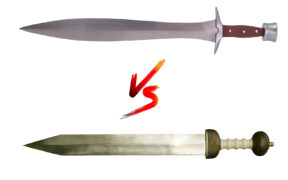A Closer Look at Roman Gladius Sword Types
NO AI USED This Article has been written and edited by our team with no help of the AI

The Roman short sword, known as the gladius, was a versatile weapon that showcased Rome’s expertise in adopting and refining highly effective arms. Over the centuries, the gladius underwent a series of modifications, influenced by technological advancements and shifts in Roman infantry tactics.
Let’s explore the three distinct types of gladius swords and highlight their differences.
Types of Gladius Swords and Their Unique Features
The term gladius, with its plural form gladii, is Latin for sword. The Roman short sword served as both a chopping and a thrusting weapon. The gladius saw gradual yet significant changes in its blade shapes and sizes over the centuries, refining its design to adapt to shifting combat needs and tactics.
Here are the three types of gladius from the Republican and Imperial periods:
1. Gladius Hispaniensis

The gladius Hispaniensis, meaning Spanish sword, was employed during Rome’s Republican period. M.C. Bishop, a renowned archaeologist and expert on Ancient Roman weaponry, noted that this sword was inspired by Celtiberian antenna swords and the Castilian La Tène sword.
In comparison to the gladius types from the later Imperial period, the gladius Hispaniensis was notably longer. Its blade typically exceeded 60 centimeters (23.6 inches) in length, with an average width of 4.5 centimeters (1.77 inches). By modern standards, this would be considered quite large for a short sword, and its design includes rounded shoulders and a slightly waisted blade.
The gladius Hispaniensis was long enough to be effective for both cavalry and infantry use. It was well-suited for slashing and thrusting, with its long point designed for stabbing. Additionally, the blade featured two cutting edges, enhancing its functionality for both cutting and chopping.
2. Mainz-Type Gladius

The gladii from the Early Imperial period are commonly classified as Mainz type, named after examples discovered in Mainz, Germany. These Mainz-type gladii resemble their predecessors in shape and proportions, featuring tapering, often waisted blades with long points, but their overall blade length was notably shorter.
Christian Miks, an expert in Roman archaeology, categorized six main blade forms within the Mainz type. All of these forms feature long points, but their blade shapes vary from the traditional waisted forms (Fulham, Classic, Sisak, and Mühlbach) to those with nearly parallel edges (Haltern-Camulodunum and Wederath).
Mainz-type blades are all very similar, indicating a standardization in blade forms and a reduction in size during the Imperial period. These blades range in length from 42.5 to 59 cm (16.7 to 23.2 inches) and in maximum width from 3.6 to 7.5 cm (1.4 to 2.9 inches). They are typically slightly waisted and were among the first to feature squared shoulders.
The Mainz-type gladius, being significantly shorter than the earlier gladius Hispaniensis, lacked the reach required for mounted troops. As a result, cavalry adopted the longer spatha. Although the Mainz-type gladius remained effective for chopping when needed, its new, shorter design was better suited for a more confined style of close-quarters combat focused on stabbing.
3. Pompeii-Type Gladius

The Pompeii-type gladius, the smallest and lightest of the three blade types, features a parallel-edged blade with a short point, resembling a shortened spatha. Developed in the mid-1st century C.E., this design aimed to create an efficient thrusting sword that still maintained effective chopping capabilities.
The Pompeii-type gladius was named by modern scholars after swords discovered in various locations around Pompeii. Christian Miks identified three primary blade forms within the Pompeii type: Hamfelde, Putensen-Vimose, and Classic.
In general, Pompeii-type gladii are smaller and lighter than the Mainz type, both in length and width. Their blades typically range from 37.5 to 56.5 cm (14.7 to 22.2 inches) in length and 3.5 to 7 cm (1.37 to 2.7 inches) in width. Like Mainz-type blades, Pompeii-type gladii also feature square shoulders.
Conclusion
The Roman gladius, versatile in both stabbing and chopping, was a key weapon in Roman combat. It evolved into three distinct types: the gladius Hispaniensis, Mainz-type gladius, and Pompeii-type gladius. Despite debates on its optimal use, the Romans employed it in whichever manner suited their tactical needs, showcasing its adaptability and effectiveness throughout their military history.





